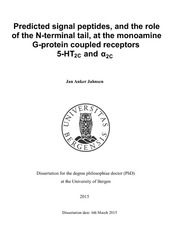| dc.contributor.author | Jahnsen, Jan Anker | en_US |
| dc.date.accessioned | 2015-03-11T14:58:50Z | |
| dc.date.available | 2015-03-11T14:58:50Z | |
| dc.date.issued | 2015-03-06 | eng |
| dc.identifier.isbn | 978-82-308-2699-7 | en_US |
| dc.identifier.uri | https://hdl.handle.net/1956/9514 | |
| dc.description.abstract | Background: G-protein coupled receptors (GPCRs) have seven transmembrane helices and are situated in the cell membrane, where they transduce signals from specific ligands to the interior of the cell. The first step in the path toward a functional GPCR is the synthesis and incorporation of the evolving receptor into the endoplasmic reticulum (ER) membrane. This process is named cotranslational translocation and is directed by a hydrophobic signal sequence located either in the N-terminus or in the first transmembrane segment (TM1). When the signal sequence is located in the N-terminus, it is cleaved off after translocation and is called a signal peptide (SP). When the signal sequence is part of the TM1 it is called a signal anchor. Monoamine GPCRs have in general short N-termini and are expected to use their TM1 as a signal anchor. Two monoamine GPCRs are nevertheless predicted by a SP prediction software to have signal peptides: The 5-HT2C receptor and the α2C-adrenoceptor. For the 5-HT2C receptor the consequence of having the predicted SP is that a single nucleotide polymorphism (SNP) will not be present in the mature receptor in the cell membrane. This SNP (Cys23Ser) has in several studies been associated with numerous clinical conditions and outcomes of pharmacotherapy. The α2C-adrenoceptor is poorly expressed at the cell surface and has a large intracellular pool of receptors. It has been shown previously for other receptors that by adding a cleavable signal peptide sequence immediately upstream to the endogenous Nterminus, the expression levels of β2- and α1D-adrenoceptor are greatly enhanced. Consequently, it is seemingly odd that the poorly expressed α2C-adrenoceptor is predicted to contain a SP. Objective: The primary aim was to determine whether the monoamine GPCRs 5- HT2C and α2C have cleavable signal peptides as predicted. A secondary aim was to determine what relevance the N-termini of the 5-HT2C and α2C receptors have for expression levels of the receptors. Materials and methods: Methods included engineering receptor constructs and chimeras by PCR and transiently transfecting COS-7 and HEK293 cells. Receptor constructs containing FLAG epitope were investigated with the primary antibodies M1 and M2 in epifluorescence and confocal microscopy. Expression levels of wild type and rebuilt receptor constructs were determined by radioligand binding performed on membrane preparations. For α2C-adrenoceptors radioligand binding was also performed on whole cells, matching the membranes, to exclude binding to an intracellular pool of receptors. Results and Conclusions: The 5-HT2C receptor has a 32 amino acid long cleavable signal peptide, as predicted by its amino acid sequence. When the signal peptide is made non-cleavable by changing one amino acid, the expression level of the receptor is reduced by 70%. We therefore conclude that a 32 amino acid long cleavable signal peptide is participating in the integration of the 5-HT2C receptor into the ER membrane. Consequently, the mature receptor does not contain the aforementioned Cys23Ser SNP. The α2C-adrenoceptor does not possess a 22 amino acid long cleavable signal peptide. Among the α2C-adrenoceptor constructs, expression was highest for the wild type receptor where the endogenous N-terminus was retained. Furthermore, all attempts at increasing the expression level of the α2C-adrenoceptor by adding a known SP or by truncating the N-tail, failed. We conclude that the Nterminus is not a major contributor to the low expression level of the α2C-adrenoceptor. | en_US |
| dc.language.iso | eng | eng |
| dc.publisher | The University of Bergen | eng |
| dc.relation.haspart | Paper I: Jahnsen JA, Uhlén S. The N-terminal region of the human 5-HT2C receptor has as a cleavable signal peptide. Eur J Pharmacol. 2012 Jun 5;684(1-3):44-50. The article is not available in BORA due to publisher restrictions. The published version is available at: <a href="http://dx.doi.org/10.1016/j.ejphar.2012.03.043" target="blank">http://dx.doi.org/10.1016/j.ejphar.2012.03.043</a> | en_US |
| dc.relation.haspart | Paper II: Jahnsen JA, Uhlén S. The predicted N-terminal signal sequence of the human α2C-adrenoceptor does not act as a functional cleavable signal peptide. Eur J Pharmacol. 2012 Jun 5;684(1-3):51-8. The article is not available in BORA due to publisher restrictions. The published version is available at: <a href="http://dx.doi.org/10.1016/j.ejphar.2012.03.044" target="blank"> http://dx.doi.org/10.1016/j.ejphar.2012.03.044</a> | en_US |
| dc.relation.haspart | Paper III: Jahnsen JA, Uhlén S. The C-terminal half of the α2C-adrenoceptor determines the receptor's membrane expression level and drug selectivity. Naunyn Schmiedebergs Arch Pharmacol. 2013 Dec;386(12):1031-40. The article is not available in BORA due to publisher restrictions. The published version is available at: <a href="http://dx.doi.org/10.1007/s00210-013-0902-z" target="blank">http://dx.doi.org/10.1007/s00210-013-0902-z</a> | en_US |
| dc.title | Predicted signal peptides, and the role of the N-terminal tail, at the monoamine G-protein coupled receptors 5-HT2c and α2c | en_US |
| dc.type | Doctoral thesis | |
| dc.rights.holder | Copyright the author. All rights reserved | |
| dc.identifier.cristin | 1226011 | |
